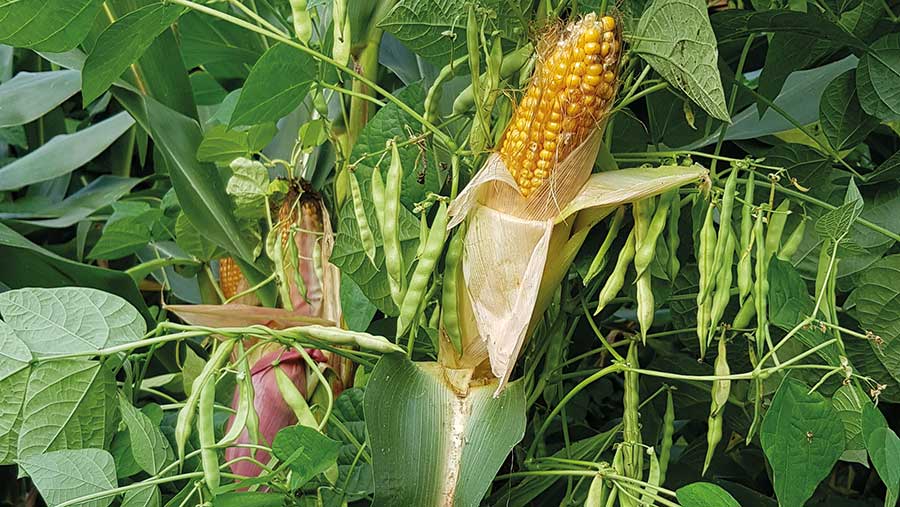How growing maize with beans can improve silage quality
 © Willmar Leiser
© Willmar Leiser Intercropping of maize and climbing beans is gaining ground among German farmers keen to improve the quality of their silage.
Yields and protein content are particularly promising when the two crops are grown together under lower nitrogen (N) conditions, according to research carried out at the University of Hohenheim.
The system also provides important biodiversity services.
“You can combine economics and ecology in a very neat way,” says Willmar Leiser, head of the university’s State Seed Breeding Institute.
See also: How to improve crude protein levels in silage
Maize-bean intercropping is a traditional practice in Latin America, especially in the land-scarce highlands.
But there is growing interest in Europe, too: in Germany, the area intercropped with maize and beans has gone from a few hectares in 2017 to 15,000ha in 2020. This year it is expected to reach 20,000ha.
Dr Leiser cites several benefits to intercropping maize and beans:
- High biomass yield
- Higher protein content
- No additional technology needed at sowing or harvest
- More biodiversity, particularly birds and insects
- N fixation and recycling (depending on soil N status)
- Better soil coverage
- Reduced risk of soil erosion.
Plant breeding
Breeding programmes in Germany have resulted in crops capable of producing very high biomass with lots of maize cobs and green bean pods at the end of the season.
Maize varieties tolerant to lodging are most suitable, as the beans climb up the maize stems and can pull them down if they are not strong enough.
Developing suitable bean (Phaseolus vulgaris) plants has been the bigger challenge, but varieties now have:
- small seeds of similar size to maize grain so the two crops can be sown together easily
- good yields
- low phasin* content
- late-maturing characteristics.
*In trials, phasin (lectin in beans) has not been found in blood or milk of cows fed maize-bean silage, and their performance has not been impaired.
Drilling and harvesting
Maize and beans can be grown in alternate rows at 37.5cm widths, but Dr Leiser advises mixing maize and bean seeds and drilling together – or buying them pre-mixed – at 75cm widths, so the beans grow up the maize in the same row, rather than growing across rows.
This allows for inter-row hoeing, practised by organic growers and an increasing number of conventional ones. It also makes harvesting easier.
Watch the video of harvesting of intercropped maize and beans at Kalkar, Germany, courtesy of Feldsaaten Freudenberger.
Yield
In trials, performance of pure stands of maize across four locations was compared to the same varieties intercropped with beans.
The total dry matter (DM) yield of the maize-beans plots was close to or equalled the maize-only yield of 18.7t/ha.
More important, says Dr Leiser, were the crude protein (CP) content results: the intercropped plots always outperformed the pure stands of maize.
While the mean average CP of the four maize hybrids grown without beans was 7%, more than half the maize-bean combinations produced CP content of 7.5%, and a few were close to 8%.
There is also potential to further increase protein content, while maintaining the same proportion of beans in the silage, by using bean varieties with higher CP concentration in their biomass.
Low N
The benefits of intercropping are even clearer with reduced N fertiliser use.
Total DM yield of maize-bean mixtures in one low-N location in 2020 exceeded the mean average DM yield of 16t/ha in the pure maize stands by as much as 2.5t/ha.
Maize and beans together also outperformed the maize-only stands in CP content, with up to 5.8% CP, compared to a pure maize average of 4.3%.
And CP yield of maize with beans was up to 1.1t of CP/ha, against a maize-only yield of 0.66t.
“This significant increase in performance under N-deficiency makes maize-bean cropping particularly attractive for organic farming, and for conventional cropping, especially in areas where N fertilisation is limited,” says Dr Leiser.
Biodiversity
The advantages of intercropping maize and beans go beyond yield and protein benefits, he adds: “The beans protect the soil from erosion, fix atmospheric N under N deficiency, provide food for insects over a long period of time and give shelter to ground-nesting birds.”
Willmar Leiser was speaking at the 2021 Maize Growers’ Association’s annual conference.
